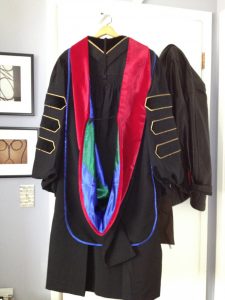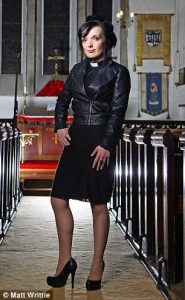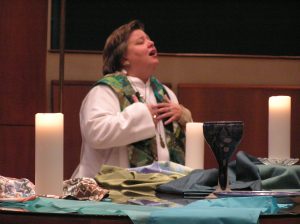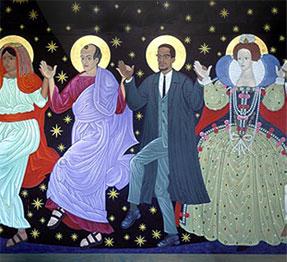I love the “dancing saints” at St. Gregory of Nissa Church in San Francisco. Completed in 2009, this wonderful 3,000 square foot painting depicts a staggering variety of traditional and surprising saints depicted in a style that recalls ancient iconography and yet all of them are dancing. The artist, Mark Dukes, collaborated with the congregation to select and choose the individuals in the painting so that “as the congregation dances around the altar, the saints dance above, proclaiming a sweeping, universal vision of God shining through human life.”
Placing icons of saints in a church is hardly new, although St. Gregory’s has definitely turned this old tradition into a vibrant new expression of 21st century postmodern faith. This painting also makes the unique vision of this congregation visible and clear. Gazing upon the unusual juxtapositions of Biblical figures with 20th century “saints” such as Harvey Milk, Anne Frank, and Malcolm X (dancing with Queen Elizabeth I) instantly conveys a vision of inclusion that makes the visitor to the church know this church is not your average church.
Yesterday was Reformation Day and it was a delight to think a bit about our spiritual ancestors from the reformed tradition including Martin Luther, Jean Calvin, and Huldrych Zwingli. The collective reforms they wrought on a corrupt medieval church were breathtaking and continue to inform the practice of many, many people all over the world, whether they participate in church or not.
The influence of Zwingli, who decried all paintings, statuary, and even pipe organs in churches, lives on in the sparse, image-free architecture of many American churches. We may have brought musical instruments back (even thought there is a tendency to hide organ pipes) and learned to enjoy art again, as long as its’ relatively abstract, but “symbols” in the sanctuary are generally limited to baptismal font, communion table, and pulpit. No dancing saints for Zwingli!
 In many churches that inherited the reformed tradition, the practice of pastors wearing medieval academic regalia including “Calvin” tabs continues. When I was a child, that black academic gown, hood, and the “tabs” that my childhood pastor wore stood out – like the dancing icons at St. Gregory’s – from what other pastors in our small town wore during worship. It proclaimed a commitment to an educated clergy and to a literate laity. And it was accurate: our pastors were highly-educated and the members of the church held many academic and professional degrees.
In many churches that inherited the reformed tradition, the practice of pastors wearing medieval academic regalia including “Calvin” tabs continues. When I was a child, that black academic gown, hood, and the “tabs” that my childhood pastor wore stood out – like the dancing icons at St. Gregory’s – from what other pastors in our small town wore during worship. It proclaimed a commitment to an educated clergy and to a literate laity. And it was accurate: our pastors were highly-educated and the members of the church held many academic and professional degrees.
Most of the churches in my small town in Texas were conservative and evangelical and their ministers did not attend seminary and often only had a high school diploma and a couple of years at Bible college. For those churches, a pastor (who was always a man) wore a suit and tie and never, ever, never wore an alb-style robe like the Catholic priest (who was Hispanic and the mass was conducted in Spanish) nor did they ever wear the black Geneva gown worn by my Presbyterian minister.
These evangelical pastors’ wardrobe symbolized their commitment to the “priesthood of believers” and their heartfelt desire to not “lord it over the people”. It also said something about their often hostile views of higher education.
They thought our pastor’s robe was offensive and it didn’t help that my pastor’s Geneva gown also made him look like a judge since the same garb is worn by the judiciary. And in the 1970’s, the great refrain from Laugh-In of “here comes da judge”, was certainly a running joke within my Presbyterian youth group every time our pastor appeared in his robe.
Flash forward to 2013, however, and liturgical drag has become as diverse as our churches. In many progressive congregations that I have served, the minister might wear an alb that recalls the medieval garb for baptism with a stole and perhaps even a cincture that might be a salute to contemplative monasticism. The alb is also thought to more closely resemble the first century clothing worn by Jesus and the disciples.
This brave new wo rld of liturgical “drag” also raises certain subtle issues related to gender. It is harder for clergywomen to figure out what to wear when they preach if robes are not an option. In a perfect world, it wouldn’t matter, but in the real world these things do matter.
rld of liturgical “drag” also raises certain subtle issues related to gender. It is harder for clergywomen to figure out what to wear when they preach if robes are not an option. In a perfect world, it wouldn’t matter, but in the real world these things do matter.
This is a constant conversation amongst clergywomen who have gotten into trouble in a particular church because a skirt was too short, a neckline too low, jewelry too flashy, or in the case of one friend, her breasts were too visible because a too narrow stole got tucked beneath her arms thereby emphasizing her breasts. On the hilarious, but really very serious website, revgalblogpals, you can purchase a t-shirt that asks, “does this pulpit make my butt look big?”
Dressing like those in the pews these days, especially in California, might lead to shorts, t-shirts, and flip-flops and I wonder whether a preacher would be taken seriously in such casual attire. And I’m absolutely sure that a dressed down man would be more acceptable in the pulpit than a dressed down woman – especially in shorts.
The Geneva gown still makes an appearance in progressive circles, but is usually reserved for Lent and Holy Week (and Reformation Day?) to provide a more somber look. Some ministers have created liturgical outfits with many multicultural references from their justice commitments. Cotton shirts from Hawaii, Mexico, the Philippines or dashikis from West Africa are common. Some clergy friends wear kimonos or saris, depending on their commitments, personal taste and personal budget for special clothing.
Amongst “emerging” christians – many of whom have left church buildings behind and are now leading worship services in bars and coffeehouses – tattoos, piercings, and leather jackets are common. Check out progressive, emerging church pastor Jay Bakker’s website to see this sort of liturgical look. (yes, he is the son of televangelists Jim and Tammy Faye Bakker)
In churches committed to diversity, it seems to me that a wide-variety of clerical garb and liturgical garments could be enjoyed as a reflection of the many wells that congregants draw from for their faith. The monastic alb tends to appeal to those who value contemplative practice. A Geneva gown certainly recalls the commitment to an educated clergy when it is worn in worship. Creative and multi-cultural stoles and robes testify to our globally-connected commitments to social justice.
 For myself, I like to wear robes (I own a white alb, an indigo cassock, and a Geneva doctoral gown that I bought when I got my D.Min.) and a beautiful collection of stoles (many made by a professional quilter in Marin County) because they make my wardrobe choices simpler.
For myself, I like to wear robes (I own a white alb, an indigo cassock, and a Geneva doctoral gown that I bought when I got my D.Min.) and a beautiful collection of stoles (many made by a professional quilter in Marin County) because they make my wardrobe choices simpler.
These garments can also add beauty to worship in much the same way that banners and beautiful flower arrangements make the church seem like a special place and not just another space for getting together in community. Wearing liturgical drag is also a bit like wearing a costume in the theater, it helps me to be “in character” and to draw my frail human self up to the task of preaching and leading worship.
It is also true that when I wear liturgical vestments, and I am also open about my identity as a lesbian, I am claiming important symbolic ground in the culture wars over the ordination of lgbt folks (and women, for that matter) So as a woman and as an out lesbian, the wearing of liturgical drag is a positive symbol of great change in some churches and a symbol of resistance in a culture that still does not always affirm this complex identity.
Symbols matter in a church. Symbols provide subtle – and sometimes not so subtle – statements about the identity, theology, and practice of a local church. But symbols also have to keep pace with the times and when it comes to liturgical garments, the commitments and identity of the one wearing the clothes also matters along with the identity of the community that minister is called to serve.

